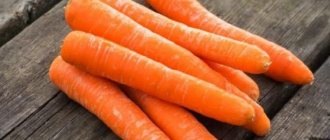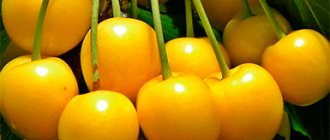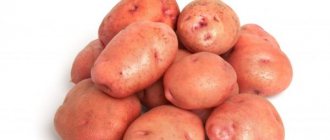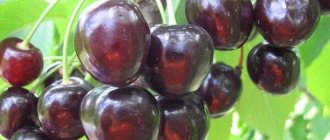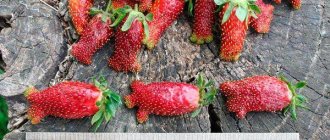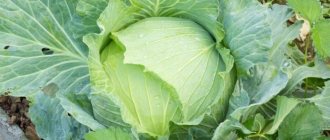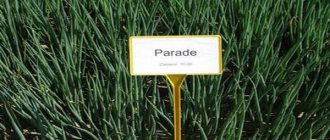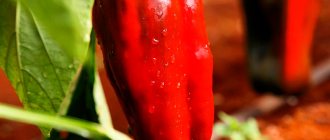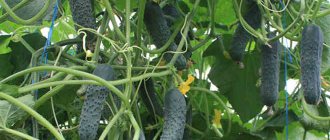Main characteristics of the Shakespeare bow
This is a winter onion for planting in the fall.
It is considered an early variety. Large bulbs of round shape. Onion with dry scales, resistant to bolting. The pulp is dense, juicy, snow-white. The taste is semi-sharp. If we compare this onion with other winter varieties, it can be noted that it has denser outer scales. Onions tolerate even severe frosts well. The harvest can be harvested in just 75 days. The absence of arrows allows him to produce a good harvest. The weight of each bulb is 100 grams. Onions have a long shelf life. This is the best choice for those who want to get tasty onions early.
Description of the variety
This variety belongs to those types of vegetable crops that ripen early. Another popular representative of winter onions is the Turbo variety.
Shakespeare onion is a winter onion variety
The bulbs have a round shape and a color ranging from yellow to brown. The pulp is quite juicy and dense. It has a semi-sharp taste, so it is perfect for lovers of spicy dishes.
Compared to other varieties of onions, it has denser scales, thanks to which it can withstand frosts down to -18 degrees. While representatives of other varieties begin to freeze already at -15 degrees. The inner scales are snow-white. The ripening period is 75 days. According to its description, the variety is similar to the Centurion onion.
During the ripening period, the mass of the bulb reaches 100 grams.
Shakespeare onions have a number of advantages over other varieties:
- the possibility of high-quality harvesting in the shortest possible time;
- high early maturity - it takes about 2.5 months for onions to fully ripen;
- large bulb size and round shape;
- juicy and dense pulp;
- high palatability and semi-sharp taste;
- a denser integumentary shell , which allows it to withstand frosts of -18 degrees;
- high disease resistance characteristic of vegetable crops.
Benefits of the Shakespeare Bow
Various varieties of winter onions
Many varieties and hybrids have been bred specifically for winter planting, and new varieties continue to appear, but not only specially bred onions are suitable for winter planting. Many spicy varieties can be used perfectly in this capacity. A number of long-used varieties have sufficient frost resistance for planting before winter, and in the southern regions almost any onion can be used as winter crops. Here is an incomplete list of varieties that are often planted before winter:
- Raider, aka Radar.
- Bow Helenas.
- Shakespeare variety.
- Bow Stuttgarter Riesen.
- Siberian annual.
- Red (or Red) Baron.
- Variety Olina.
- Goliath (or Goliath as he is sometimes called).
- Ellan (also called simply Elan).
- White onions.
- Troy.
- Variety Centurion.
- Senshui elow.
And this is not the entire list of varieties that are used for sowing before winter. They differ in planting and care, or rather, in the methods of doing so. They also have different appearance and, of course, taste. These varieties are distinguished by their pungency, while others have a milder and even sweetish taste. But the description will not help here: to see all these differences, you need to plant the desired variety, and then taste the harvest. Therefore, it is worth describing several of the varieties that are recommended by experienced gardeners.
Onion variety Troy
This variety was bred in Holland not so long ago, but has already proven itself well when grown in plots. Troy onion is a so-called first-generation hybrid from which you cannot get seeds. This variety of Dutch selection is not distinguished by large rhizomes. A dozen medium-sized bulbs rarely weigh more than 1 kg, but they are resistant to environmental influences and can be stored for a long time. And this despite the fact that the variety belongs to the medium-hot varieties.
The bulbs of this hybrid are round in shape, with smooth and dense shiny scales of a golden hue. They are very reluctant to shoot. For this reason, Troy has a long shelf life and excellent germination: the onions do not begin to fall into the feathers ahead of schedule. It can be planted not only before winter, but also in spring. This variety does not suffer from fungal diseases and has good resistance to various viruses, bacteria and pests. An excellent choice for both the novice gardener and the experienced summer resident.
Bow Centurion
Another first generation hybrid, which, like Troy, was bred by breeders in Holland. These varieties also have a certain external similarity, but Centurion has slightly more elongated bulbs, and its scales are lighter, with a bright straw hue. The weight of one rhizome rarely exceeds 100 g, which is generally average, but this is compensated by the high yield and excellent germination of Centurion onions. It ripens in three months, so in warm regions the winter crop is harvested as early as June.
The bulbs of this hybrid do not contain much moisture. For this reason, they can be stored for six months, and under suitable conditions this period may increase. The fruits have a moderately pungent taste, so they are used both for salads and for preparing various canned foods. Due to the dense and durable scales of the outer cover, the onion retains its presentation for a long time, which simplifies its successful sale. If you look at the reviews, you will find out that this hybrid is considered one of the most popular varieties at present.
Winter onion Radar
The Radar onion, also known as the Raider, is another hybrid that has been successfully grown as a winter onion. This variety has one difference, for which all knowledgeable gardeners appreciate it: it is resistant to very severe frosts, even compared to many other winter varieties. The radar can withstand temperatures down to -15°C, and this is in the absence of snow cover. Under the snow, it is able to withstand frosts even down to -23°C. These are very respectable indicators.
Frost resistance is not the only advantage of this hybrid. The weight of its bulbs ranges from 150 to 300 g, and in some cases can reach half a kilogram. They have a classic round shape and a golden hue to their scales. At the same time, they are able to ripen quickly. Some summer residents manage to harvest their crops already in May, when other gardeners are just beginning to see greens. At the same time, Radar has a pleasant pungent taste, thanks to which it is successfully used in various cooking.
Bow Stuttgarter Riesen
This variety was bred in Germany, but it is in no way inferior to the brainchild of Dutch breeders. This onion can be used both for obtaining green feathers and for growing turnips. In both capacities, he shows himself excellently. When grown for turnips, its yield is 4.5-5 kg per 1 sq. m of beds, although here a lot depends on the quality of the soil and planting density. Stuttgarter Riesen also has a high ripening speed: 100 days pass from the appearance of the first shoots to harvesting.
This variety is characterized by large bulbs, the weight of which ranges from 120 to 250 g. They have a somewhat flattened, neat shape, dense golden scales and white flesh. They also have a medium-sharp taste, which is characteristic of many varieties of winter onions. The variety is resistant to a number of fungal diseases, in particular to all types of powdery mildew. It is stored for a long time and retains its presentation, which is why it is convenient for growing, both for home use and for sale.
Winter onion variety Shakespeare
This variety can be used very successfully both for planting before winter and for classic spring cultivation. This hybrid belongs to the ultra-early varieties. Its average ripening period is 2.5 months, which is one of the best indicators in principle. As with Radar, the bulbs can be harvested as early as May or early June. At the same time, the bulbs are very resistant to bolting and will not germinate ahead of time, so this variety is excellent for storing not only the harvest, but also the planting material.
The average weight of one bulb ranges from 80 to 100 g - an average figure when compared with other varieties, but these bulbs tolerate frost well and can withstand temperatures as low as -18°C. This happens thanks to the strong and dense scales that make up the outer cover of the rhizome. These scales have a golden hue, while the flesh of ripe fruits is white.
Another advantage of the Shakespeare variety is that it does not require abundant watering.
Variety Senshui yellow
Senshui elow, or Senshui yellow, is a very convenient hybrid to grow, the distinctive feature of which is the color of the rhizomes. Its scales have a yellow tint with a brown tint, which is easy to recognize in the photo. But Senshui is popular not because of the color of the bulbs. This variety is distinguished by its fast ripening time - harvesting occurs already in mid-June, and in warm regions it can be done even in May, if climatic conditions permit. Moreover, this variety has excellent germination.
The taste of the bulbs is somewhat sweet, without any pronounced pungency, so they are convenient to use in preparing salads and other similar dishes. But there is one problem with this: Senshui does not have the best shelf life - the bulbs last no more than 3-4 months, after which they begin to deteriorate. But the variety has excellent disease resistance, which has a positive effect on the harvest.
Winter onion Ellan
This variety is one of the first winter onion varieties bred by domestic breeders. According to many gardeners, Ellan is perfect for growing in central Russia. Moreover, it can be grown with short daylight hours, which allows it to be planted in some northern regions. The average weight of one bulb is 110 g, although individual rhizomes can reach a weight of 0.4-0.5 kg. It all depends on the conditions of detention and some luck.
The rhizomes are round in shape, with dense yellowish scales, sweet in taste and without pronounced pungency, but because of this the crop cannot be stored for a long time, so it should be sold immediately or used for food, which is not difficult, given that turnips are harvested already in the first place. half of June.
How to choose planting material
The quality and volume of the harvest depends on the quality of the planting material. Seeds should only be purchased from familiar gardeners or in a specialized store. It is best to use sets to propagate this Dutch onion variety. The bulbs should be about one centimeter in diameter. Experienced gardeners believe that this material produces the best onions, which can be stored for a long time.
Each bulb must be carefully inspected before planting. There should be no rot, spots or damage on it. Infected bulbs should not be used, otherwise the entire crop may be damaged. This set can be grown without soaking before planting, without treating it with anything, without cutting off the necks.
To make onions comfortable in the beds, it is better to plant winter Shakespeare onions only in areas where grain crops (except oats), beets, cabbage, tomatoes, rapeseed, and mustard grew. You cannot plant where onions, garlic, cucumbers, and carrots sprout.
You may be interested in: Sturon onions, planting before winter, how to grow properly
Harvesting and storing onions
Onion harvesting begins approximately 70 days after the first shoots. The bulbs are carefully dug up using a fork, pulled out of the ground, and shaken off any adhering soil. The onions should lie in the open air for a while (two weeks, if there is no precipitation), then the bulbs are transferred under a canopy for final drying. Once the necks of the bulbs are dry, you need to cut off the roots and the rest of the stem. If the onion will be stored in boxes, you can leave only a couple of centimeters of the neck, and for braiding you need to leave part of the stem. Shakespeare onions will be stored in a cool place for up to six months.
Planting onions: how to plant seeds, timing, technology
After removing the predecessor plants from the soil, the ground should be dug up and humus added. After this, you need to give about one month time for the soil to shrink before planting in winter.
Sowing in forest-steppe areas takes place approximately on August 10-15, and in steppe areas on August 25-30 . You should not plant before this time, as the number of arrows will increase in the spring.
Immediately before sowing the seeds in the ground, the garden should be watered and after the soil has dried slightly, the area should be loosened and leveled. The distance between the rows of onions should be 35-40 cm. The approximate seed consumption per linear meter of row is 35-40 viable seeds. The seeds are sown to a depth of 1.5-2 cm and the soil on top is slightly compacted. If August is sunny and hot, you should monitor watering, preventing the soil from drying out.
Winter onions are planted to a depth of 1.5-2 cm at a distance of 25-35 cm between the beds
The first shoots can already be seen on days 18-20.
Harvest and storage
Harvesting occurs 2.5 months after germination. It is advisable to carry out cleaning in dry, windy weather. If the soil is light, then the bulbs can be carefully pulled out of the ground with your hands by the feather. It is better not to pull them out of heavy soil, but to dig them up with a pitchfork - otherwise you can leave the tip in the ground, and without it the bulbs will not be stored for long. The selected crop must be laid out in the sun to dry. After this, it is laid out in wooden boxes and placed in a dry, well-ventilated place.
Planting onions in winter
Winter planting of onions requires compliance with many rules. It will not be enough to stick the bulbs into the ground for them to grow. You need to take care of the condition of the soil, the height of the beds, the quality of planting material, you need to carefully care for the planting in the spring, and carefully protect it from frost in the winter.
Preparing soil and beds
You need to start preparing for planting winter onions in August. Then you should choose a place for a garden bed on your garden plot. The best place for an onion bed is sunny and dry. Water should not accumulate in this place, it should be constantly illuminated by sunlight, and there should be no tall trees nearby that cast shadows.
The areas chosen for the beds are carefully dug up, the deeper the better. At the same time as digging, organic fertilizers are added to the soil: humus and compost. If the soil is too acidic, wood ash is added to it. Clay is added to too sandy soils, and sand to clayey soils. This will make the soil ideally suited for growing onions.
Onion beds are made high, approximately 15-20 cm in height. Until planting time, they are left alone; the soil should settle on its own; it should not be compacted. Otherwise, after planting, the soil will settle and the seeds will remain on the surface.
Timing and planting of onions
Seeds begin to be planted in early October, but seeds for onion sets need to be planted at the end of August. Of course, the climatic conditions of the region in which the planting will take place are of great importance. Planting dates can be shifted to the end of September in the north or the second half of October in the southern regions, the main thing is to plant before frost sets in. If the soil freezes, it will be difficult to establish the root system necessary for successful wintering. The average planting time is a week before frost.
Shakespeare onions are planted in nests (3-4 pieces per hole) or in rows. The neck of the bulbs should be deepened by several centimeters. Between the rows the gaps are about 20 cm, between the holes no more than 10 cm.
After planting, it is necessary to cover the planted seeds with a mixture of humus and peat. The top of the bed needs to be mulched. It is better to use organic materials. This is hay, dry leaves, bean leaves. Gardeners do not recommend using plastic film; unnecessary moisture accumulates under it. In the northern regions of the country, dry branches and spruce branches are used to insulate beds. In the Krasnodar Territory, winters are warmer; additional insulation of the beds is not required. In the spring, the mulch is removed so that the bed warms up well under the first rays of the sun and the bulbs hatch.
You may be interested in: Onion Radar, planting before winter with a guarantee of a good harvest
Planting onions before winter provides undeniable advantages. In early spring, the onion will already sprout and grow quickly. This growing method can save time for spring work on the site, of which gardeners have a lot at this time.
Features of planting and growing
When growing the variety, follow agrotechnical rules and recommendations to achieve the desired results.
Preparing for landing
It is best to use sets for planting Shakespeare . It is desirable that the bulbs have a diameter of about 1 cm.
Attention. Be sure to check each bulb before planting. It should be free of rot, stains and other damage.
The advantage of the variety is that the sets are planted without prior soaking and processing. In addition, there is no need to trim the necks of the bulbs.
When growing onions, it is important to observe crop rotation . The vegetable will grow better in areas where the following crops previously grew:
- all grains except oats;
- cabbage;
- rape;
- beet;
- tomatoes;
- mustard.
onions after garlic, carrots, oats, cucumbers and onions.
Soil requirements
Onions prefer sandy and loamy soils . The vegetable does not develop on too dense (clayey) soil. It is also picky about soil acidity. The culture grows well in neutral or slightly alkaline soil, where the pH level is from 6.4 to 7.9.
Preparing the soil for planting begins with digging and removing all plant debris and weeds. The soil must be nutritious. To do this, the soil can be fertilized with the following composition :
You can add wood ash to the soil . It is especially good to use in acidified areas. Clay lands are enriched with sand, and sandy lands are enriched with clay.
Select a place for planting that is dry and sunny ; liquid should not accumulate there.
Dates, scheme and rules of planting
Sevok is planted in early October , but the seeds for it are planted at the end of August. However, the climatic conditions of planting are of great importance. So, in Siberia the dates will be shifted to the end of September. And in the southern regions, on the contrary, in the second half of October. But keep in mind that the seedlings are planted before frosts occur, about a week before them.
The Shakespeare variety can be planted either one bulb at a time or in nests of 3-4 pieces in one hole . In this case, the neck of the bulb is deepened a couple of centimeters. The distance between the rows is 20 cm. And between the holes no more than 10 cm.
After the onions are planted, cover them with a mixture of humus and peat . And the top of the bed needs to be mulched. Hay or dry leaves are good for this. In regions where winters are warm, additional insulation is not required.
In the spring, the mulch is removed to allow the bed to warm up under the sun's rays and for the bulbs to begin to sprout.
Features of cultivation
variety is suitable for sowing in open ground . The ground is first loosened or dug up - it depends on the type of soil. 10-14 days before planting, the bed is sprinkled with wood ash and mixed with a flat cutter.
Important! The crop cannot be planted in lowlands, otherwise the plantings may be flooded with meltwater.
During cultivation, use nitrogen fertilizers strictly according to the instructions . They are able to provoke the growth of green mass, while the bulbs themselves will not develop.
Nuances of care
When growing Shakespeare onions, it is important to follow the basic rules of care : watering, weeding and fertilizing.
Planting Shakespeare onions before winter
Despite the fact that Shakespeare onions are resistant to disease and can be cultivated without prior disinfection of planting material, it is recommended to immerse the bulbs in a container with a solution of potassium permanganate for 10 minutes. This will further increase its resistance and strengthen the planting material. After this, the bulbs are thoroughly dried.
Winter onions Shakespeare are planted in the ground at a distance of about 3 cm from each other. Most often it is planted one bulb at a time, but nest planting of 3-4 heads per planting hole is also practiced. The optimal depth for planting material is 3 cm. Deeper planting will make it difficult for plantings to emerge in the spring, and if planted superficially, the plants may freeze out in winter.
About 200 g of planting material is consumed for each square meter. This is approximately 40-45 onions.
In regions with cold winters, such as the Urals or Siberia, it is recommended to use mulch on Shakespeare onions. Before winter, hay, straw or dry leaves are used as mulching material. Medium-sized tree branches are placed on top of them so that the wind does not blow away the shelter. If in winter the temperature drops to -12℃ or lower, snow should be thrown on top of the plants.
With the onset of spring, when the risk of severe frost has passed, the mulch should be removed as quickly as possible. If this is not done, the plantings run the risk of rotting.
To protect onions from spring frosts, agrofibre is used, which retains heat and transmits the light of the sun.
If agrofibre is not available, transparent polyethylene film can be used as an alternative. However, this material does not have the advantages of agrofibre, so it is used only at night and removed during the day.
If the plot is not located on an elevated place, it is necessary to ensure that water does not accumulate on the site during the melting of snow masses.
Onion care: fertilizing, watering, loosening
After the onions have been planted in the fall and securely covered with mulch, you can forget about them until spring. The exception is winters that are too cold but snowless. Then you will need to visit the site several times to make sure that there is enough snow on the beds, and if necessary, add snow from the paths. You can install special shields or lay branches so that they hold back the snow during a snowfall, preventing the wind from exposing the beds. It is effective to use special agrofibre; it has good light transmittance and insulates well.
In the spring, you need to remove the mulch from the beds and sprinkle the beds with a thin layer of wood ash. This will nourish the soil, helping the green shoots gain strength. During the period of formation of green onion feathers, you can add another fertilizer - potassium phosphate. It is better if they are in liquid form, so that the nutrients are distributed evenly. During this period, you can thin out the beds if the onions grow too thick. The pulled out bulbs can be eaten.
Watering the beds is carried out as necessary. Excessive amounts of moisture in the soil, as well as drying out of the soil, are very destructive for onions. The soil is loosened after watering, otherwise a crust will form on the surface of the soil.
You definitely need to weed the weeds. Weeds should not be allowed to multiply. They deprive the plant of nutrients, pulling them out of the soil. Large weeds can shade the onion crop. Weeds are carriers of diseases.
Pest and disease control
To preserve the crop, it is necessary to protect it from pests, of which there are a lot. The most common pest is the onion fly. You can plant calendula or marigolds near the onion beds; they repel flies.
You may be interested in: Onions for feathers, planting for the winter, growing green onions
Do not treat onions with pesticides. To prevent the proliferation of diseases and pests, you need to observe crop rotation, carefully prepare planting material, and cultivate the soil before planting. Which fertilizer is suitable? If the plant becomes infected, you can treat it with biological products Gliokladin, Alirin, Fitosporin-M. Spraying with ready-made preparations Fitoverm, Agrovertin will help against pests. Dosage and methods of use are described on the packages.
The right approach to choosing a variety
Having decided to sow onions before winter, you need to choose a variety suitable for this. Of course, it is best to give preference to special winter varieties and hybrids, but if this is not possible, then from the general variety of varieties, you can choose the most suitable onion, taking into account the following nuances:
- Varieties with a high level of frost resistance and hybrids with short daylight hours are suitable for autumn sowing.
- The sharper the taste of a vegetable, the higher its resistance to freezing.
- It is impossible to plant “outlandish” varieties zoned for the southern regions before winter.
- Experience shows that before winter it is better to sow onions with yellow colored husks.
Important! Spring varieties with low frost resistance, sown in autumn, often freeze slightly and shoot in the spring.
Thus, for pre-winter planting, it is better to choose onions that are zoned for a specific area and are highly resistant to freezing. Winter varieties obviously have all the necessary qualities for successful wintering.
Landing rules
In order to grow onions belonging to the winter variety Shakespeare to the highest possible quality, you must strictly follow all planting rules.
It is recommended to start sowing this popular winter variety in early October. Although the climatic conditions of a particular region also play a certain role here. But, in any case, planting should be completed before the first frost, until the soil freezes - in this case, it will be provided with reliable rooting for a successful wintering.
To grow this variety of onion, as well as other winter crops, you should select dry areas with plenty of sunlight and protection from the wind. Before you start planting onions for the winter, you need to thoroughly loosen the soil and feed it with fertilizers. For the most effective fertilizing, it is recommended to use humus and compost mixed with wood ash. For growing Shakespeare onions, it is recommended that the height of the beds be at least 15-20 centimeters, however, before planting, the soil must be thoroughly compacted.
How to plant these winter onions is up to you. This can be done either in even rows or in nests containing 3-4 bulbs. The maximum distance between planting material is 10 centimeters, and between rows - from 15 to 20 centimeters. The planting material should be covered with a mixture of peat and humus on top.
Harvesting and storage conditions
You should start harvesting onions 70 days after the sprouts emerge. To do this, it is recommended to carefully dig up the fruits with a pitchfork and pull them out of the ground. Remove any remaining soil and spread the vegetables out to dry. After which the crop must be placed under a canopy so that it is completely dry. It is important to trim the roots and remaining stems.
Fruits must be kept in a cool room. They can be stored for six months. It is important to choose a dry room without mold. Onions should not be stored in conditions of high humidity. Vegetables can be kept in boxes or braided from them.
Growing Shakespeare onions is accessible and simple. To achieve success in this matter and reap a bountiful harvest, you need to choose the right timing and place for planting. This winter crop appeared relatively recently in domestic gardens, but has already won the sympathy of summer residents.
Caring for winter beds
Winter onions, their planting and caring for them are inextricably linked. Immediately after the beds have been prepared, they must be covered with mulching material, which can protect them from winter frosts. Winter onion sets can suffer from cold weather, so you need to immediately decide what will be used as a shelter. Often ordinary leaves of garden trees are taken and laid on top of the plantings. But there is a better option for care - laying pre-collected pine needles on the beds.
Fertilizer for winter onions must be applied in the spring, and the first application is made soon after the snow melts and the soil thaws. After this, the main care consists of timely watering and loosening the beds. If the sowing was successful, then soon after warming the first green arrows will appear in the beds, but after them pests will come that will need to be fought. Moreover, the more delicious the variety was planted, the more it will attract various unpleasant insects.
Some gardeners ask how to plant winter onions so that they suffer less from insects, and whether there are winter onions at all that do not attract pests. Unfortunately, these uninvited guests must be constantly dealt with. Before planting, it is worth treating the soil with products against tobacco thrips, onion flies and nematodes, and in the spring, plant regular carrots near the beds. At the same time, you need to constantly monitor the condition of your crops. Here's what they recommend about this on various gardener forums:
“Winter onions attract many pests when they begin to ripen. When the time for harvesting approaches - and this happens in June or July - it is worth preparing for an insect invasion. Of course, when we plant winter crops, we treat the soil against pests before planting. But it is worth preparing products such as Medvetox or Aktara for protection before harvesting. You can also prepare infusions from plants such as dope, henbane, marigold or alkaloid lupine. These environmentally friendly products have already proven their usefulness.”
Care
The most successful harvest will be if the gardener takes proper care of it and follows all the subtleties of growing onions. The product requires timely watering, removal of weeds from the area, loosening and other methods of care. How to properly water onions in open ground is described here.
One of the main importance in caring for onions is the soil. If the region where you are going to plant onions experiences constant or frequent frosts, it would be best to cover the plantings with mulch. Dry material such as hay or straw is used as mulch to allow air to still escape into the beds. To prevent the wind from blowing away the mulch, it is recommended to place medium-sized branches on top, otherwise you will crush the plantings.
Instead of canvas, you can also use film; it does not really protect against frost, but it protects the beds from excess moisture. It is necessary to actively ensure that water does not fill the holes and allows the bulbs to breathe.
Closer to spring, when frost activity disappears and the earth begins to warm up, the mulch is removed.
Watering the product is also a major part of caring for vegetable crops. After planting, onions do not need watering. In the spring there is frequent precipitation, which brings enormous moisture to the soil in such a way that there is practically no need for watering. However, if the soil consumes too much moisture, it can cause rotting of the planting material.
If the spring was rainy, watering should begin in June
The first time Shakespeare onions are watered no earlier than in the second half of May, since the variety is already sufficiently saturated with moisture, and precipitation stops and moisture is still needed. If spring is rainy, then watering should begin no earlier than June.
Fertilizing also affects the quality and harvest. Fertilizing is first applied when the bulbs begin to ripen. The next feeding begins 2 weeks after the first. Complementary feeding is necessary for the growth of bulbs and their further maturation. Read more about feeding onions for a good harvest at this link.
Plant care
Without proper care of Shakespeare onion plantations, they risk dying over time or producing an insufficiently high and high-quality harvest.
Watering
At first, Shakespeare variety plants practically do not need irrigation, since the soil is already saturated with water, and excess moisture can only cause rotting of the bulbs and the development of diseases. The first irrigation is carried out only in the second half of May. If there is a high amount of precipitation in the spring, then the timing of this procedure is moved to June.
Drying out the soil is also unacceptable. Without sufficient moisture, plants may die. For irrigation, use warm water that has settled for several days. Irrigation is carried out in the morning or late evening. Water is poured onto the ground next to the plants, being careful not to get on the onion itself, so as not to provoke burns and diseases. At the end of each watering, the soil is loosened. This increases air circulation in the soil, saturates the roots with oxygen and moisture. At the same time, this procedure allows you to destroy weeds on the site.
Feeding
The first application of fertilizers occurs when the first shoots form on the plot. For this purpose, cow manure and nitrogen fertilizers are used, which are diluted with water. The next feeding is carried out 2 weeks after planting
On the Shakespeare variety, it is important to observe the dosage of nutrients, since it reacts very negatively to an excess of fertilizers, especially nitrogenous ones
During the period of formation of green feathers, onions are fed with phosphorus-potassium fertilizers. At the same time, it is allowed to thin out the plantings if they are too thick.
Reviews on growing winter onions
The popularity of winter onions has grown sharply in recent years. According to the experience of farmers, on average, onions planted in autumn ripen 35 days earlier. Cultivation of classic varieties reduces the yield of vegetable crops. Therefore, gardeners advise using specially bred hybrids.
You can get winter onions not only by winter planting. Some breeding varieties are designed for sowing in mid-July. In this case, the bulbs ripen at the end of May. But, as practice shows, using regular onions, for example, the Red Baron variety, can provide a good harvest.
Reviews of the Shakespeare variety
In general, reviews of the Shakespeare bow are positive .
After all, this is one of the few non-shooting varieties. And many summer residents note its delicate taste and aroma. Igor, Baymak : “Every year I plant the winter variety Shakespeare and get a magnificent harvest of delicious onions.
He has no arrows, which is very pleasing. For fertilizers, I only use wood ash and humus.” Tamara, Taganrog : “Shakespeare is very convenient to plant before winter. I start watering only in May or June. The harvest is always abundant. The bulbs themselves grow even and beautiful.”
Lyudmila, Baymak : “I recently learned about the variety, but it has become a favorite on my site. I plant in the fall, and in the spring I already have a bed full of seedlings. But do not forget to apply fertilizers on time. I use mullein infusion for feeding.”
How to choose planting material
It is important to pay due attention to the choice of planting material for Shakespeare onions. You should purchase seeds only from the most reliable and trusted suppliers with a good reputation.
To propagate winter onions of the Shakespeare variety, it is recommended to use sets with a diameter of 1 centimeter. According to experienced vegetable growers, onions grown from such small sets can be preserved for as long as possible.
Small onions do not produce shoots; heads grown from them are much better stored in winter
When choosing a seed for growing the Shakespeare variety, you should carefully consider each small onion. If the set contains defects in the form of damage, spots or, especially, rot, it cannot be used.
It is not recommended to plant winter onion sets in areas where any onion varieties, as well as potatoes, legumes, carrots and cucumbers, have been grown for five years in a row. It is favorable to grow Shakespeare onions on the soil where tomatoes, cabbage, rapeseed, beets, mustard, as well as grain crops with the exception of oats previously grew.
Cultivation of winter onions: pros and cons
Sales of spring onion sets (tykanka) begin in February. When purchasing planting material, gardeners are faced with the problem of its preservation before sowing.
Sevok reacts very sensitively to the slightest changes in storage conditions (humidity, temperature). It may begin to sprout or deteriorate (rot), but it must be preserved until the end of April or even until May. Planting material that has not been stored correctly may end up in arrows during planting.
There are no such problems with winter onions. High-quality seedlings begin to be planted from the second half of August until the first frost (depending on the variety and region).
Important advantages of winter onions include larger and juicier heads than those of ordinary spring onions. This is due to the fact that in the spring it begins to develop during the most favorable period. Determining the optimal planting time for spring crops is difficult.
There will be no need to water winter onions until mid-May, since there is enough moisture in the soil for its development and growth.
It is important that winter onions ripen three to four weeks earlier than spring onions. And juicy green feathers and bulbs for culinary needs will be available by the end of May.
The main disadvantage of winter crops is that its yield is slightly lower than spring crops. There is also an opinion that winter onions are not preserved as well as the harvest of spring varieties. However, after preliminary drying (with dried husks), mature bulbs of winter varieties can be stored for quite a long time without loss of presentation and taste.
Choosing an onion variety for winter cultivation
For a plant used for autumn-spring cultivation, two parameters are important: frost resistance and good growth with short daylight hours. In order to survive the cold winter, a vegetable planted in the fall must take root and adapt in a short autumn time. Late varieties of onions reveal their qualities only with long daylight hours, so it makes no sense to use their bulbs for planting. It is also useless to plant bulbs of southern varieties, which reveal their qualities only during high summer temperatures.
Note! An incorrectly selected variety after wintering does not grow a bulb, but an arrow.
A large number of onion varieties for winter planting have been bred by Russian and Dutch agronomists.
Arzamas
The variety was bred by folk breeders in the last century. It is adapted for cultivation in central Russia and the Urals. The bulb is round, its weight reaches 80 grams. The color of the husk is dark yellow with a brown tint. The taste of the onion is very pungent. The variety is mid-season, from seed germination to tops lodging - 70-90 days. The harvest can be up to three kilograms per square meter. The disadvantage of the Arzamas variety is its poor resistance to downy mildew.
Danilovsky
The variety was bred by agronomists of the Yaroslavl region. It grows well almost throughout Russia. The bulb is round-flat, its weight can reach up to 160 grams. The color of the husk is red-violet. The taste of the onion is mild, slightly sweet. The Danilovsky onion variety is used in canning and preparing dishes and salads. The variety is mid-season. When grown from seeds, the harvest is harvested 110-120 days after planting, when grown from sets – after 90-100. The harvest reaches three kilograms per square meter.
Radar
The hybrid is the product of the work of Dutch agronomists. The variety is zoned throughout the Russian Federation. The bulb grows weighing up to three hundred grams, round in shape, golden yellow in color. Designed for the use of winter sowing agricultural technology, it tolerates frosts down to minus 23 degrees. The variety is resistant to bolting, practically does not get sick and is not affected by pests. The variety is early ripening; when planting the seeds in winter, the harvest is obtained in early June.
Note! Radar is a hybrid variety and is not intended for propagation at home.
Red Baron
The Red Baron variety was developed by Dutch agronomists. The variety grows well almost throughout Russia. The bulb is flat-oval in shape. With good care, its weight can reach up to 200 grams. The color of the pulp and scales of the vegetable is burgundy. Due to the unusual color of the pulp, Red Baron is often used to decorate dishes on the holiday table. The taste of the vegetable is mildly spicy. A distinctive feature of the Red Baron variety is the absence of characteristic onion bitterness in the taste. The variety is an early ripening variety; the harvest is harvested within three months after planting. Its yield reaches up to four kilograms per square meter. A distinctive feature of the Red Baron variety is the absence of characteristic onion bitterness in the taste.
Senshui
The result of the work of Japanese breeders, Senshui onions grow well throughout almost the entire territory of Russia. The variety is specially bred for winter planting. The bulb grows weighing up to 250 grams, flat in shape, straw-yellow in color. The variety has a pungent taste. The variety is an early ripening variety, harvested in early summer. Senshui is very frost-resistant. The bulbs can withstand frosts up to 15 degrees. With proper care, the variety's yield reaches 4 kilograms per square meter.
Strigunovsky
The ancient onion variety Strigunovsky was bred by Russian agronomists. The variety is intended for cultivation in central Russia. The bulbs are round, their weight reaches 120 grams. The color of the scales is yellow. The Strigunovsky onion variety has a pungent taste. The variety is early ripening; when planted in winter, the harvest is obtained in early summer. The yield of the variety reaches three kilograms per square meter.
Sturon
The result of the work of Dutch agronomists is the Sturon onion. The variety was bred by selection from the common Stuttgarten Riesen variety. Sturon is intended for cultivation throughout almost the entire territory of Russia. The variety is frost-resistant; bulbs planted in the ground do not freeze out in winter. The bulbs are round, slightly elongated, their weight reaches 220 grams. The color of the scales is yellow-brown. Sturon onions have an exceptionally sharp, bitter taste. The variety is early ripening; when planted in winter, the harvest is obtained in early summer. The yield of the variety reaches three and a half kilograms per square meter.
Note! If optimal conditions are created, Sturon can be stored for 9 months.
Centurion
The result of the work of Dutch agronomists is the Centurion F1 onion. The variety is intended for cultivation throughout almost the entire territory of Russia. The bulbs have an elongated shape, their weight reaches 120 grams. The color of the scales is yellow. The taste of onions is delicate, medium-hot, the vegetable is perfect for salads and preparations. The variety is early ripening; when planted in winter, the harvest is obtained in early summer. The yield of the variety reaches four kilograms per square meter. The centurion rarely shoots arrows and practically never gets sick.
Shakespeare
The result of the work of Dutch agronomists is Shakespeare onions. The variety was bred for winter sowing and is intended for cultivation in the central and northern regions of the Russian Federation. The bulbs are round, slightly flattened, their weight reaches 100 grams. The color of the scales is yellow-brown. The onion taste is medium hot. The variety is early ripening; when planted in winter, the harvest is obtained in early summer. The yield of the variety reaches three kilograms per square meter. Shakespeare is exceptionally resistant to disease and very rarely shoots arrows.
Stuttgarten Riesen
Stuttgarten Riesen was bred by German breeders. The variety grows well almost throughout Russia. The bulbs are round, slightly flattened, their weight reaches two hundred and fifty grams. The color of the scales is yellow. The taste of onion is semi-sharp. The variety is mid-season; the yield of the Stuttgarten Riesen variety, with proper care, reaches eight kilograms per square meter. Stuttgarten Riesen is resistant to diseases and parasites.
Ellan
The onion variety Ellan was relatively recently bred by Kuban breeders. The variety is adapted for cultivation throughout the Russian Federation. The bulbs are round, the bulk of the crop weighs 100 grams, but with good care, individual specimens reach a weight of half a kilogram. Onions have a sweet taste, so they are well used in salads, in preparing a variety of dishes and preparations. The variety is early ripening; when planted in winter, the harvest is obtained in early summer. Thanks to its sweet taste and lack of bitterness, Ellan onions can be eaten by people with gastrointestinal diseases.
Sources used:
- https://proposadki.ru/ovoshhi/luk/shekspir
- https://fermoved.ru/luk/ozimyj.html
- https://poferme.com/ogorod/ovoshhi/luk/ozimyj.html
- https://1rassada.ru/ovoshhi/luk-shekspir-opisanie-ozimogo-sorta-pravila-posadki-i-uhod
- https://fermilon.ru/sad-i-ogorod/ovoshhi/sorta-luka-pod-zimnyuyu-posadku.html
- https://osobnyachkom.ru/cultivation/vegetables/ozimyj-luk-shekspir.html
- https://poferme.com/ogorod/ovoshhi/luk/shekspir.html
- https://luckclub.ru/ozimyj-luk-sorta-posadka-uhod-v-sibiri-na-urale-v-podmoskove-v-ukraine
- https://vogorode.com/ogorod/bah/ozimye-sorta-luka.html
- https://ogorod-bez-hlopot.ru/ozimyj-luk.html
Characteristics of the variety
Dutch onion Shakespeare is an early ripening variety. The ripening period is 75 days. Shakespeare's fruits are round in shape, covered with a thin husk, the color of which varies from yellow to brown.
The lower layers of the husk are located very densely.
The bulbs are quite large, reaching a mass of 100 grams. Sometimes they grow even larger, up to 250 grams. However, growing such a bulb at home is quite difficult.
Shakespeare's productivity is also high. With good care, you can safely collect up to 3.5 kg of quality bulbs from 1 m2.
